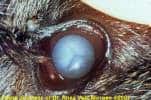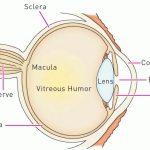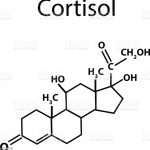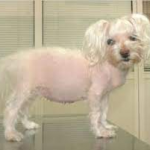Most diabetic dogs will develop cataracts and go blind. This FAQ is designed to assist the owners of diabetic dogs in knowing what to expect and to make decisions regarding cataract surgery.
What Is A Cataract?
A cataract is an opacity in the lens of the eye. The entire lens may be involved or just a part of it. The patient will not be able to see through the opacity.
Why Do Diabetic Dogs Get Cataracts?
The lens of the eye is round, hard, and normally as clear as glass. Looking at the lens it is hard to believe it is a piece of living tissue. The lens is suspended by fibers that can adjust its position so that one can focus vision. The lens is encased in a capsule and depends on the fluids of the eye for nutrients. The lens does not receive a direct blood supply.
Normally, the lens absorbs glucose from the eye fluids, using most of this for its own energy needs. Some of the excess is converted to another sugar called sorbitol. When there is excess sugar in the eye fluids, as in diabetes mellitus, there is excess sorbitol produced. Sorbitol pulls water into the lens, which in turn disrupts lens clarity and causes the cataract. Fructose is also produced from the excess glucose and also contributes to this water imbibition.
Cataracts do not necessarily imply poor diabetic control. Even well controlled dogs still can get cataracts.
How Long Does It Take To Go Blind?
Generally the cataract has matured and the dog is blind in a matter of weeks.
Until recently, blindness in a diabetic dog was basically a foregone conclusion but there is a new product called Kinostat® that has changed that outlook. To review, the lens absorbs glucose from the fluids of the eye and uses this glucose as nutrition. Any extra glucose that is absorbed into the lens is converted to sorbitol by an enzyme called aldose reductase.
Sorbitol pulls water into the lens to prevent the lens from becoming dehydrated. This is all well and good but in the diabetic state there is lots of excess glucose and the excess glucose gets converted to excess sorbitol which, in turn, pulls so much water into the lens that clarity and function are disrupted and a cataract is formed. Kinostat is an aldose reductase inhibitor that curtails sorbitol production. Early use of Kinostat may significantly delay or even completely prevent the development of cataracts.
Kinostat is a preventive only and will not reverse cataract formation that has already occurred. Kinostat is unfortunately not yet commercially available.
What Does It Mean To Say That A Cataract Is Mature?
A cataract’s maturity is determined by how much visual impairment the pet is believed to have. Since we cannot ask a dog to read an eye chart, we must determine this by visually inspecting the eye. A light is used to look into the eye and view the colorful area at the back of the eye called the tapetum. (This is the area that flashes or appears colored in certain lighting.) When less than 10 percent of the tapetum is obstructed, the cataract is very young and does not significantly change vision. When 10-50 percent of the tapetum is obstructed, this cataract is called early immature. When 51-99 percent is obstructed the cataract is late immature. The mature cataract obstructs the entire tapetum. Ideally a cataract is removed in the early immature stage for the lowest surgical complication rate.
When a cataract is hypermature, it is starting to liquefy and dissolve. This can actually lead
to restoring vision, which sounds like a positive turn of events; unfortunately the dissolution process is quite inflammatory. The resulting inflammation can be painful and can damage the eye even more.
All cataracts do not progress all the way to hypermature and may stay static or progress at changing rates; however, diabetic cataracts are notorious for reaching hypermaturity and creating inflammation.
What Is Uveitis?
Uveitis is inflammation of the eye’s uveal tract, which consists of the eye’s vascular tissues. In this situation, uveitis is the inflammation that results when the hypermature cataract begins to liquefy. Uveitis is painful and tends to cause the eye to become reddened and the pupil to constrict. When a pet has uveitis before surgery, success (pain-free vision) occurs in only 50 percent of cases 6 months after surgery as opposed to 95 percent of cases for whom there was no uveitis pre-opertively.
Can My Dog’s Vision Be Restored?
Maybe; it depends on the health of the eye excluding the cataract. If the only thing wrong with the eye is the cataract and the patient’s diabetes mellitus is well regulated, surgery can remove the cataract and place an artificial lens. If the eye is deeply inflamed or is otherwise damaged, the eye may be blind even without a cataract. A veterinary ophthalmologist can evaluate the eye to determine the feasibility of cataract surgery.




